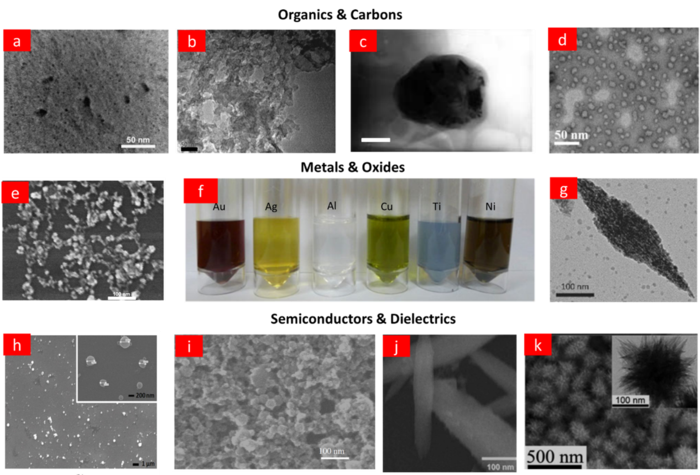Functional nonlinear optical nanoparticles created by laser ablation have been discussed in a recent publication from Opto-Electronic Science.
 Various types of nonlinear optical nanoparticles fabricated by laser ablation. Image Credit: OEA (Opto-Electronic Advances).
Various types of nonlinear optical nanoparticles fabricated by laser ablation. Image Credit: OEA (Opto-Electronic Advances).
Nonlinear optics is a growing field with applications in laser manufacturing, nanostructure creation, sensor design, optoelectronics, biophotonics, and quantum optics, among other fields. Nonlinear optical materials are essential building elements in a wide range of sectors, including scientific research, industrial production, and military applications.
Nonlinear optics has become the foundation of several different frontier research programs and widely utilized optical systems, including laser manufacturing, optical imaging, information processing and communications, and nanoscale lithography, after many years of progress. Advances in this field have the potential to benefit a wide range of disciplines.
Nanotechnologies have cleared the path for the development of novel materials and the breaking of nonlinear optics’ traditional constraints. Nanoparticles are one of the most thoroughly researched members, with a history dating back thousands of years.
Nanoparticles have a lot of potential since they can create and improve their nonlinear optical characteristics more easily than their bulk counterparts. Optical systems and components based on nonlinear optical nanoparticles have gotten a lot of interest in the last decade because of their improved performance and multifunctional capabilities.
Many of them are also biocompatible, which broadens the range of applications for nonlinear optical systems.
Nanoparticles are commonly employed in nonlinear optical applications due to the benefits listed above. How to make nonlinear optical nanoparticles on a large scale, with great reproducibility, and at a reasonable cost remains a difficulty in nanoparticle synthesis.
Various synthesis procedures have been studied to overcome this difficulty. The two most common methods of synthesis are chemical and laser ablation. Chemical methods can be used to make nanoparticles on a large scale. There are other limits to chemical techniques, such as contaminants and agglomeration.
Laser ablation, on the other hand, provides a more direct, ecologically benign, and ubiquitous way of making nonlinear optical nanoparticles. For applications based on nonlinear optical nanoparticles, there is a lot of flexibility and options to meet the needs of various devices.
Prof. Hong Minghui’s research group at the National University of Singapore examines recent advances in nonlinear optics linked to light amplitude/intensity. Saturable absorption and optical limiting are two nonlinear processes that characterize a material system’s transmission change.
Saturable absorption occurs when light absorption diminishes as light intensity increases. In other words, with higher incoming light irradiation, a material with saturable absorption tends to be more “transparent.” High-power lasers are frequently made from materials having saturable absorption. The optical limitation, on the other hand, describes the inverse effect.
When the light intensity increases, an optical limiting material lowers light transmission. As a result, the reverse saturable absorption is used to describe the optical limitation. It is also a key effect in a variety of applications, including protective materials, military weaponry, optical switching, and high-power laser sources.
Despite their relevance, saturable absorption and optical limiting usually necessitate high-intensity incident light. As a result, they are usually seen in systems that use a high-peak-power pulsed laser. This problem has the potential to cause irreversible vision impairment.
It is also a significant impediment, limiting practical uses due to the intricate design and expensive cost of high-power lasers. The main research direction in this topic is the quest for appropriate materials with exceptional nonlinear characteristics.
The advancements will not only improve the performance of current optical nonlinear systems, but will also open up new avenues for designing functional devices to meet the growing demands for quantum optics, advanced sensors, artificial intelligence, next-generation optical computers, and a variety of other frontier topics.
This review outlines recent work in this area, focusing more on methodology and illuminating a number of case examples. It also covers issues more in-depth to give a better perspective on their significant benefits and accomplishments.
Another focus is on problems and future research trends, with recent research efforts introducing new opportunities and potentials. The progress of nonlinear optical nanoparticles created by laser ablation is discussed, demonstrating their capacity to perform numerous roles and improve performance.
Laser ablation synthesis of nanoparticles is a green, efficient, and universal physical technique that can do a quick one-step synthesis and large manufacturing.
Journal Reference:
Chen, L, et al. (2022) Functional nonlinear optical nanoparticles synthesized by laser ablation. Opto-Electronic Science doi:10.29026/oes.2022.210007.